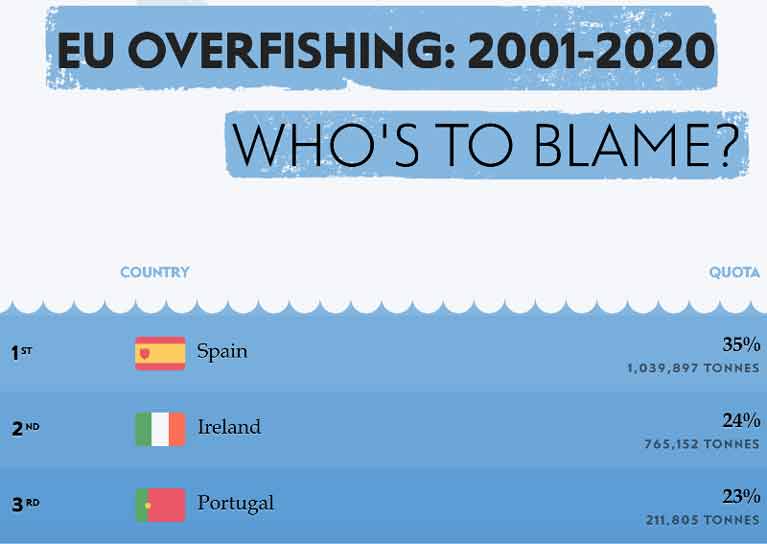A new environmental report on fish catches in EU waters ranks Ireland among the top five in a European “overfishing league table”.
The report by the New Economics Foundation (NEF) has claimed that Spain, Ireland, Portugal, the Netherlands and Germany all gained the highest percentage of quotas “above scientifically advised levels for sustainable limits” over a 20-year period.
However, most “excess tonnage” of fish has been caught by Britain, Denmark and Spain – at 1.78M tonnes, 1.48M tonnes and 1.04M tonnes respectively – over two decades, the report says.
In an initial response, the European Commission’s maritime directorate DG Mare has said that while 70 per cent of stocks in the north-east Atlantic were “overfished”, there have been “significant improvements over the past 20 years” which have led to a forecast this year that 99 per cent of all fish landed is at “sustainable levels”.
Killybegs Fishermen’s Organisation chief executive Sean O’Donoghue questioned the methodology used and said that on an initial examination, the NEF report did not appear to make a valid case for its conclusions.
The NEF and non-governmental organisation “Our Fish” claim that collectively the EU member states have overfished by 8.78 million tonnes during the last two decades.
The NEF is a London-based charity which is funded by a number of trusts and foundations.
 A report by the New Economics Foundation (NEF) has claimed that Spain, Ireland, Portugal, the Netherlands and Germany all gained the highest percentage of quotas “above scientifically advised levels for sustainable limits” over a 20-year period
A report by the New Economics Foundation (NEF) has claimed that Spain, Ireland, Portugal, the Netherlands and Germany all gained the highest percentage of quotas “above scientifically advised levels for sustainable limits” over a 20-year period
The two organisations have called on the EU and its member states to “include ending overfishing” and “restoring ocean health” in the EU Green Deal on the basis of their findings.
The report was prepared before the full impact of the Covid-19 pandemic which has tied up many fleets due to a dramatic fall in prices and restrictions or closures of market and supply chains.
Its analysis for Ireland over the past two decades says that “on average, quotas were set 24% above scientific advice in Ireland’s favour, placing Ireland second on the “overfishing league table” behind Spain.
It says that from 2001 to 2020 Ireland set 765,000 tonnes of quota above scientific advice, placing Ireland sixth in tonnes.
The report notes that “some quotas are consistently set above advice including pollack in the Celtic Sea, herring to the west of Scotland and Ireland”.
It says that “the Irish fishing industry and government work in close coordination, with Minister [Michael] Creed, explicitly citing an industry representative as shaping his behaviour”.
Our Fish spokesman Mike Walker commented that “as Irish political parties negotiate a new government, this report should serve as evidence of the causes of the biodiversity and climate emergency, and exemplify how responsible fisheries management could restore the marine environment and the communities who rely on it”.
NEF senior researcher Griffin Carpenter said that if the EU “delivered on its commitment to end overfishing and rebuild damaged fish stocks to sustainable levels, it could create over 20,000 new jobs, provide food for 89 million people, and generate an extra €1.6 billion in annual revenue”.
The NEF analysis calculates that six out of ten total allowable catches (TACs) were set above scientific advice between 2001 and 2020 on average.
“While the percentage by which TACs were set above advice declined throughout this period (from 39% to 10% in all EU waters), the proportion of TACs set above advice has had a lesser decline, from eight out of ten TACs to five out of ten,”it says.
A European Commission spokesman said that “while we are yet to familiarise ourselves with the details of this report and the underlying methodology, it is important to note that the Common Fisheries Policy (CFP) has led to significant improvements in sustainable fisheries in the north-east Atlantic over the past 20 years”.
“In certain cases, scientists do not have enough data to determine with confidence the sustainable catch level,” the spokesman said.
“ We are working with member states to improve the data for the scientists continuously,” the spokesman said.
“The interpretation of catch levels for those stocks with limited scientific assessment can lead to different conclusions as regards the overall sustainability of fisheries,” he said.
“Oceans not only contribute to climate change mitigation but also provide us with healthy and nutritious food,” the spokesman said, with “a much lower environmental impact” compared to terrestrial food production.
“. It is important that seafood is derived in a sustainable way, which does not compromise marine ecosystems. In this respect, the CFP will play a key role in ensuring the continued provision of sustainable fish protein to the consumers,” the spokesman said.
“The European Maritime and Fisheries Fund will also play an important role in this transition. One-third of the future fund is expected to contribute to climate objectives, thus contributing to the achievement of an overall target of 25 % of the EU budget supporting these objectives,” the spokesman said.































































